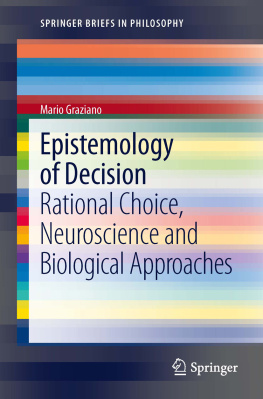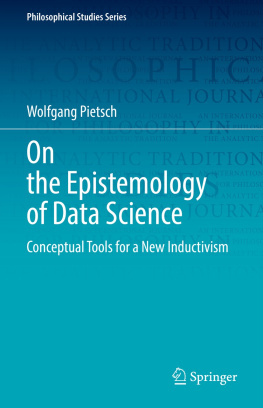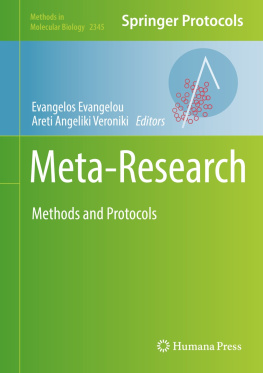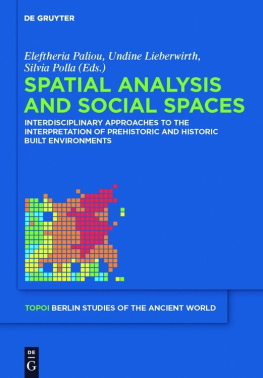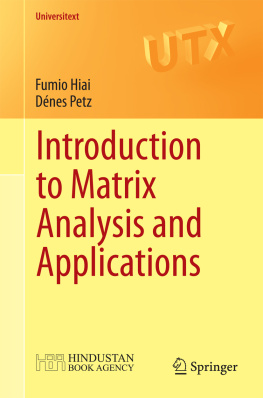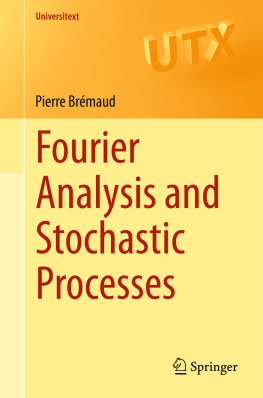Mario Graziano SpringerBriefs in Philosophy Epistemology of Decision 2013 Rational Choice, Neuroscience and Biological Approaches 10.1007/978-94-007-5428-7_1 The Author(s) 2013
1. Rationality and Experimental Economics
1.1 The Theory of Rational Choice
The theory of rational choice (TRC) is a model of explanation used by social science theorists to interpret behavior. Initially, the theory was the dominant paradigm of economics. A fundamental postulate of neoclassical economics was that economic phenomena primarily resulted from the action of agents who were fully rational, equal and therefore indistinguishable from each other and all agents pursuing their own personal and individual gain. This postulate was followed by another epistemological postulate that found in economic phenomena the possibility of applying general laws expressed in mathematical terms as was achieved in physics. These postulates have been translated into fine mathematical models, reaching essentially hypothetical-deductive conclusions obtained from a basic idea introduced during the classical era by John Stuart Mill in his Principles of Political Economy, according to which economic phenomena comprise individuals who are all indistinguishable from one other, acting as agent-atoms in economic processes (Bertuglia and Vaio ).
Therefore, the assumption of neoclassical economics to establish economics as a mathematical economics attempted to identify a suitable role to play, as energy plays in physics, i.e., to find a function able to locate the maximum and minimum to define states of equilibrium. This comparative measure is utility, introduced several decades earlier by Jeremy Bentham (). According to the dominant interpretation of neoclassical theory, rational choice consists of acting to maximize personal gain, i.e., the option that allows the realization of the highest level of satisfaction for the agent. The latter determines the action: choose the greatest profit or the lesser evil. Therefore, during the deliberations, the agent compares opportunities and chooses the alternative that is more advantageous for him according to his beliefs. In brief, this option maximizes the difference between its costs and its advantages. The theory is limited to this instrumental concept of rationality: A choice is made based on the expected results (as when, for example, we undertake a program of university study in view of the salary we expect from the labor market). A rational agents process of deliberation invariably begins by examining every opportunity in relation to each other and only in relation to his preferences. An agent is driven on the one hand by his beliefs, that is, by his information and expectations of the possible consequences, and on the other hand, by his desire for them.
Rational analysis generally begins with the premise that an agent wishes to choose what he invariably prefers. However, this premise is only part of the equation. The other important element in decision-making is the presence of specific constraints that make the choice necessary, and one virtue of the rational approach is to explicitly illustrate the pros and cons of possible alternatives. Therefore, a choice is rational if it corresponds to the scale of the agents preferences, which is obtained by comparing various opportunities possible and converting preferences into utility functions. However, this conversion is possible only if the preference structure complies with certain restrictions: the four axioms of rational choice, namely, reflexivity, completeness, transitivity and continuity. The axioms function within the rational model as follows. First, the choice of an agent is rational if it conforms to his scale of preferences. Associated with different possible options, the latter (preferences) should always possess a value equal to themselves. Preferences must therefore be reflexive: (xi = xi). This condition is purely a formal necessity and depends on common sense. The second axiom, completeness, is necessarily involved in the structural formation of the agents preferences. In fact, it is agreed that preferences can be ordered: (xi xj) or (xj xi). An individual must be able to compare all options and then prefer one or be indifferent because of their equivalence. Third, the scale of preferences must be transitive, i.e., it must conform to the classic example showing that if a person prefers an orange to an apple and an apple to a pear, then he must also prefer an orange to a pear. The order of preference must simply reflect an internal coherence; there must be no ambiguity. Finally, an agents preferences must be constant. To illustrate this last condition, let us again consider the example of an agent faced with a choice of various goods. Two goods can be contained within a single set, and their quantity in the same can be amended to allow a comparison of the utility of each choice. Therefore, this axiom stipulates that there is no good that is absolutely necessary to a set and that cannot be exchanged for another. Thus, reflexivity and transitivity determine the order of preferences, whereas completeness and continuity are the conditions that allow a representation of the utility function. Ultimately, the rational choice theory offers an instrumental conception of rationality conceived as a coherent relationship between preferences, information and action.
Considering the axioms of rationality presented above, we can understand why the theory enjoys a special status among the social sciences. The theorys ideas are parallel to the developments and needs of other disciplines; analytical strength and operational effectiveness. In addition to responding to the needs of the social sciences, i.e., to describe, predict and prescribe, the theory performs an analytical theorization of social phenomena and explains it using clear arguments and assumptions. Insistence on these factors grants the theory special status in the social sciences and a role that transcends the areas covered by the economic sciences. The theorys importance derives from the fact that it avoids categorizing the explanation of individual actions as a question of fact, and it allows predictions from what is postulated. In fact, in addition to conceiving and describing behavior as a process of maximization, the theory is able to predict the latter, again according to the criterion of maximization.
In 1944, John von Neumann and Oskar Morgenstern proposed the rational choice model in relation to decision processes in which for every choice, more consequences could be related, which completed the entire picture of the dominant paradigm. Specifically, in the renowned work The Theory of Games and Economic Behavior, the authors formulate the so-called theory of expected utility in which the function of utility (expected) was determined from the totality of the associated utility and from the possible results multiplied by their probability of occurrence. In essence, when one is faced with two alternatives, X will be preferred to Y based solely on the expected utility of X is greater than the expected utility of Y. To understand how the theory of expected utility functions, it is best to offer an example: An employee must decide whether to accept an offer of employment from agency A rather than from agency B, in which both agencies initially offered an equivalent beginning salary. Moreover, if the employee accepts the offer of agency A, he or she has a 50 % chance of obtaining a salary increase of 20 % during the first year of employment. However, if the employee accepts the offer of agency B, there is a 90 % chance that the salary increases by 10 % in the first year. According to the theory of expected utility, the employee must multiply the utility of the result of every alternative by the probability of obtaining that result; hence, the expected utility associated with the first option will be 0.50 U (20), and the expected utility associated with the second option would be 0.90 U (10). Moreover, one must note that the theory of expected utility does not prescribe what one must choose in the case of the given example of the employee. In other words, the theory focuses on the structure of the preferences rather than on their content because the objective of both authors was not to describe individuals real behavior but to indicate how they should have acted based on the criteria of the coherent logic of the preferences and the calculation of the probabilities that one can hypothesize in the elaboration of the information. Therefore, overall, economic theory has opted for a formal approach. The function of utility used in economics was nothing other than a way of mathematically representing the order of individual preferences.

